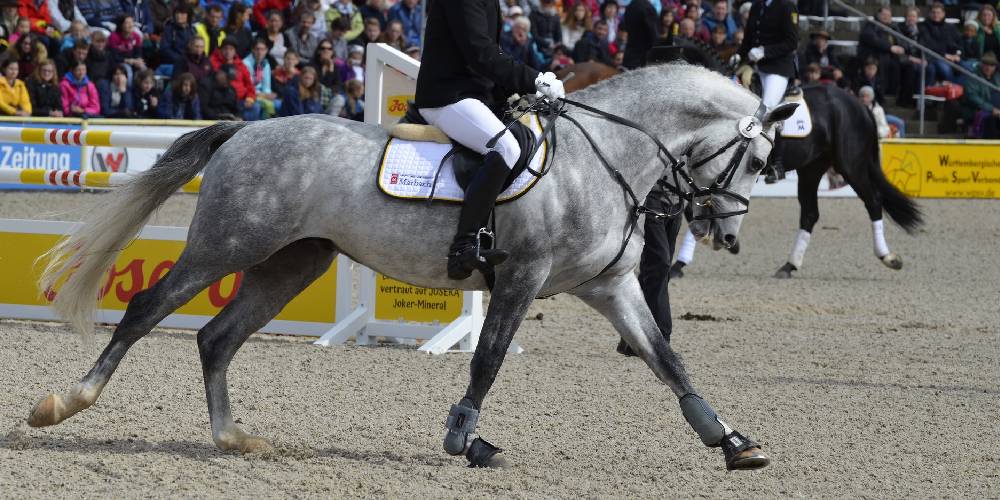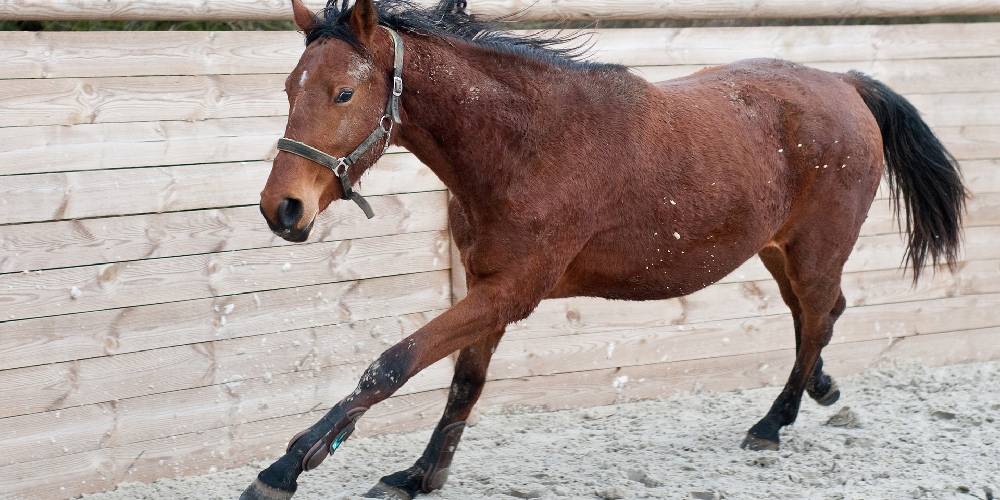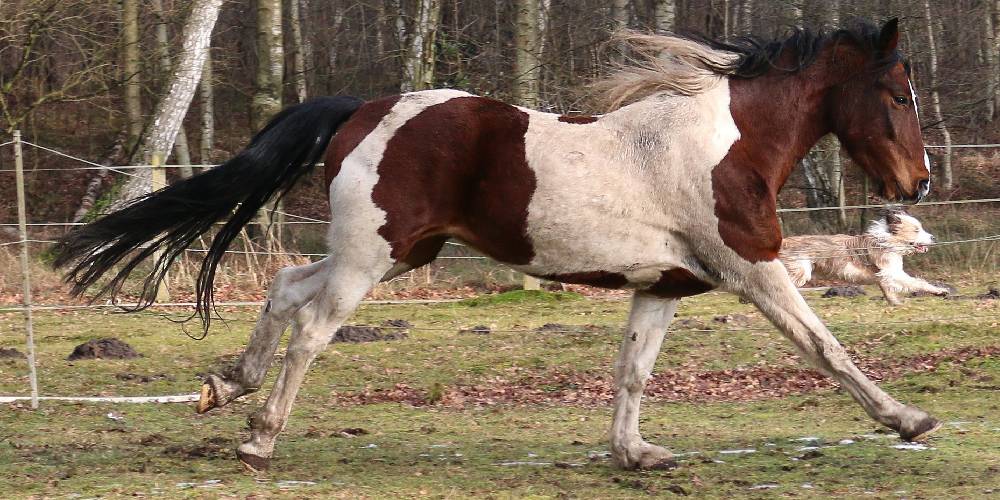The canter, a fast gain often confused with the gallop, is a gait that has three beats. The canter can be identified by looking at a number of different things. What are the different ways to identify the canter? Are there other names for the canter? And what are leads?
What Is the Canter?
The canter is a gait that consists of three beats. This means that in one stride, the horse’s hooves will hit the ground three times. The canter is the third-fastest gait that every horse will naturally perform. Compared to the gallop, the canter is more controlled and the horse will actually lead the canter with either their right or left front leg. This gait is a fast-paced gait that on average will clock in between 10 and 20 miles per hour (16 to 32 kilometers per hour) depending on the size of the horse and the length of the horse’s stride.
How Can You Tell When A Horse Is Cantering?
You can tell a horse is cantering by observing a few different things. One of the ways to tell that a horse is cantering is by listening to their hoof beats. If you can hear three beats per one stride that a horse takes, they are most likely cantering.
Another way to tell that a horse is cantering is by looking at the motion of the horse’s feet and legs. At the canter, one of the horse’s front legs will appear to be moving forward or ahead of the others. This leg would be leading the gait. When a horse is leading with, say the left front leg, the right front, and the rear left leg would hit the ground at the same time and the rear right would hit the ground on its own. This would be reversed if the horse was leading with the right leg.
The image below might help to better explain the canter:

Another way to identify the horse’s canter is by looking at the rider. The rider will most likely be sitting down for the canter though some will two-point the canter. You may notice, that the rider will rock their lower body gently with the movement of the horse.
How Fast Is The Canter?
The canter is an extremely fast gait that, depending on the horse, the horse’s size, and the length of the horse’s stride, will reach speeds between 10 and 20 miles per hour (16 to 32 kilometers per hour!).
The canter is also the third fastest gait that all horses are able to perform naturally.
Is The Canter Smooth Or Bumpy To Ride?
Every horse is different! I ride a mare named Olivia who has a canter that is so so so difficult to sit and ride because of how bumpy and aggressive it is, yet there are horses like the lesson horse I rode named Trump whose canter feels like you are floating along on a pile of feathers. All horses are different, but on average, the canter is actually pretty smooth to ride. Smoother than the trot that is.
How Can You Easily Ride The Canter?

Having ridden a number of horses at the canter, there are a few tips I can give you that might improve your riding of the canter. These are:
Put More Weight In Your Stirrups
I will admit it, but I am one of those riders that constantly loses my stirrups, especially when I am cantering. By putting more weight in my stirrups, this not only helps me to keep my stirrups under my feet, but it also helps to keep me balanced and centered on the horse.
I also recommend keeping more weight on the outside stirrup. The reason for this is because if you are making a circle, keeping consistent weight in your outside stirrup doesn’t allow you to fall towards the middle of the circle you are making.
Sit On Your Seat
Sit back!!! I make this mistake ALL THE TIME!! I always find myself leaning forward with the canter and sitting on my crotch rather than my seat which puts me in the perfect position to get bucked off (which tends to happen a little more often than I would like to admit). Sitting on your seat and keeping your posture upright will greatly improve your canter!
Rotate Your Hips In A Small Circle
This might sound funny, but I promise that this helps. The center of balance of a horse at the canter is actually in a small circle. When you are cantering, swivel yout seat in a circle with your outside hip moving forward (right lead go in a clockwise circle, left lead go in a counterclockwise circle).
Look Ahead
Look ahead! Just like when driving a car, you want to look up where you going and not down at your lap. The reason for this is otherwise you might crash or temporarily lose control of the car. The same goes for horses. If you look ahead where you are going it will not only better your direction and communication with your horse, but it will also naturally keep your body upright and centered with your horse.
Keep Constant Contact
Some horses need to be brought up so they are more up under themselves rather than stretching out long and potentially tripping. To fix this, make sure you have enough contact both with your horse’s head and with your legs.
With not enough contact, the horse may not understand what exactly you are asking of him and they might begin to trip as they aren’t picking up their canter as much as they should.
With too much contact, the horse may be confused as to whether you want them to stop or go forward and misbehavior might occur including actions like throwing their head to try to get more rein, and cantering in place.
Maintain Your Horse’s Speed
Don’t let your horse get too caught up in his speed! Too fast can lead to problems really quick. The reason for this is because of the fact that maintaining a controlled canter is important not only for presentation and obedience, but also for safety.
Do You Sit Down Or Stand Up For The Canter?
You can do either! Sitting for the canter is more common in riding than standing (two-pointing) for the canter though both are easy ways to ride this gait. If you are jumping or going really fast, standing for the canter may be an easier thing to do than sitting it as it already puts you in a better position for what you are doing. Sitting the canter helps the horse to relax more and promotes a more steady gait. Whatever you need in a canter can be done either standing or sitting, just decide what’s better for you!
What Is A Lead?

A lead is basically the leading leg in the canter. If a horse is on the left lead, this basically means that the left leg of the horse is stretching forward more or ‘leading’ the gait. If the horse is on the right lead, the horse is stretching the right leg forward more and ‘leading’ the gait.
How Can I Tell If My Horse Is On The Correct Lead?
When you are riding, you can look down and see which leg extends more. You can also feel it too if your horse is on the incorrect lead because of the way it feels. The incorrect lead makes the ride feel unbalanced and the horse won’t bend properly.
If you notice your horse is on the wrong lead, you can easily fix it by asking for a lead change or stopping and asking for the canter and correct lead again.

